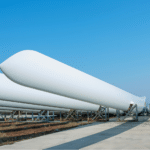
Master Blade Repair with Expert Training at Wind Trade Academy
September 4, 2024
Start Your Training Journey to Success Now
November 5, 2024As we strive to combat climate change and transition to renewable energy sources, floating wind turbines are emerging as a groundbreaking solution in offshore wind energy. These innovative structures promise to transform the way we harness wind power, especially in deepwater regions where traditional fixed-bottom turbines fall short. By unlocking the potential of deeper waters, floating wind turbines are poised to play a critical role in our move towards sustainable energy.
Understanding Floating Wind Turbines
Floating wind turbines mark a significant leap in wind energy technology. Unlike conventional offshore wind turbines that are anchored to the seabed, floating wind turbines float on the ocean’s surface and are held in place by cables anchored to the seabed. This design allows them to operate in deeper waters, where fixed-bottom turbines cannot reach. Here are some of the key advantages of floating wind turbines:
- Access to Deepwater Wind Power: Floating turbines can be placed in deeper waters where the wind is stronger and more consistent. This access to higher wind speeds translates to increased wind-generated energy.
- Increased Energy Generation: By tapping into these powerful wind currents, floating wind turbines can capture more wind energy compared to their shallow-water counterparts. This makes them a more cost-effective and efficient option for generating electricity.


The Benefits of Floating Wind Farms
Floating wind farms bring a host of benefits for both energy production and environmental impact:
- Enhanced Energy Generation:
- Stronger Winds: The ability to operate in deeper waters allows floating wind turbines to take advantage of stronger and more consistent winds, boosting their energy output.
- Higher Energy Output: With increased wind speeds comes greater energy production, making floating wind farms a powerful source of clean energy. This makes them a technologically advanced solution in the realm of wind energy.
- Environmental Advantages:
- Reduced Visual Impact: Located farther from shore, floating wind turbines are less visible from land, reducing their visual impact on coastal areas.
- Less Marine Disruption: By avoiding shallow waters, these turbines help preserve marine ecosystems that might otherwise be disturbed by traditional turbines.
Technological Innovations in Offshore Engineering
The development of floating wind turbines involves advanced offshore engineering and marine infrastructure. Key innovations include:
- Floating Platforms:
- Design Types: Floating wind turbines use various platform designs, such as spar-buoy, semi-submersible, and tension-leg platforms. These designs ensure stability and functionality even in challenging marine conditions.
- Turbine Blades: Technologically advanced turbine blades are used to maximize energy capture and efficiency.
- Advancements in Wind Energy Technology:
- Materials: The use of lightweight, durable materials in construction helps reduce costs and improve performance.
- Construction Techniques: Automated and efficient installation methods contribute to making floating wind farms more cost-effective.
Looking Ahead
Floating wind turbines represent a crucial step forward in renewable energy development. As technology advances and costs decrease, their role in generating clean energy will become increasingly significant. Additionally, floating wind farms have the potential to benefit local communities through job creation and economic growth, particularly in regions like the United States. By investing in these cutting-edge technologies, we can enhance our energy security and contribute to a greener, more sustainable future.For further insights into the advancements in floating wind farms, check out this article on a semi-submersible wind farm that has made significant strides in energy generation: Semi-Submersible Wind Farm Hits 320 GWh.




